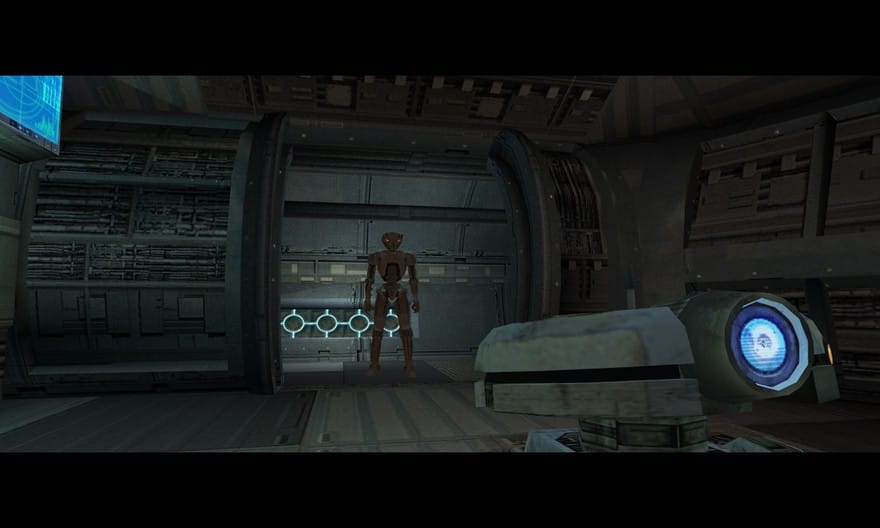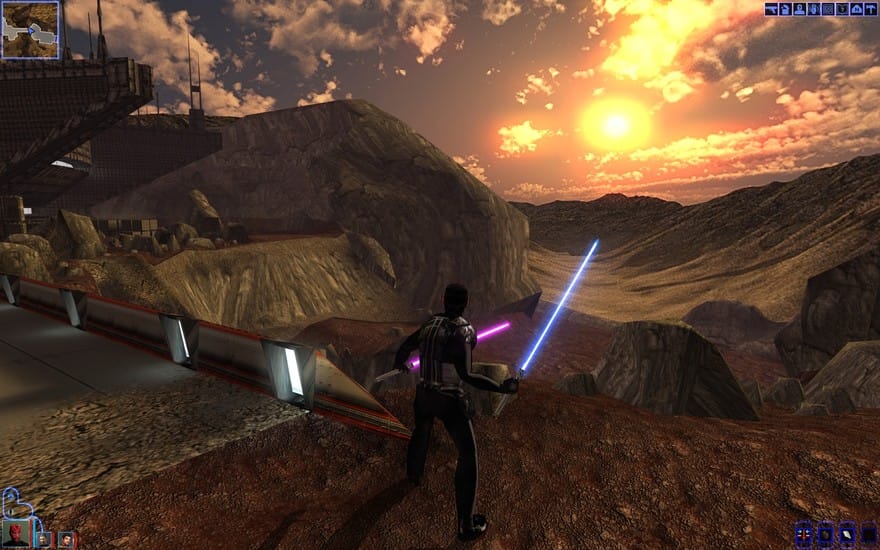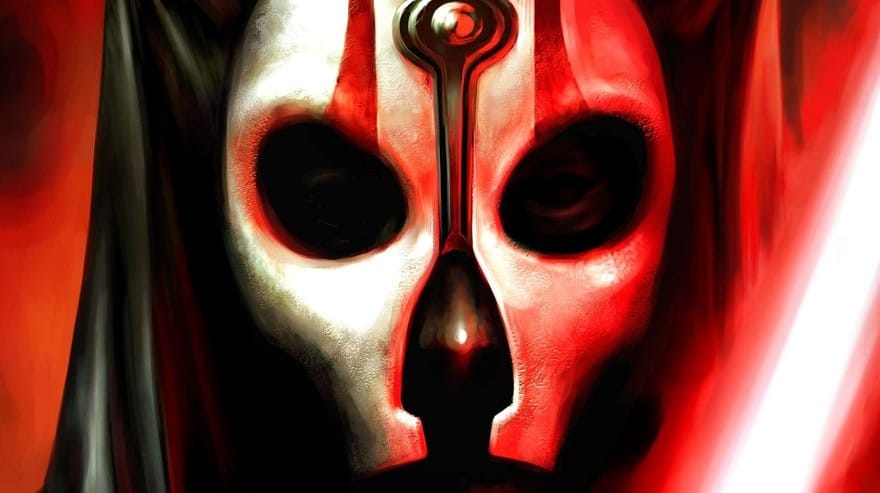Vanishing Points

Star Wars: Knights of the Old Republic II: The Sith Lords opens with a blank numbness. A ship is careening through deep space, barely holding itself together. As an insignificant little robot, you desperately fix it. One tutorial later, the game cuts to an unadorned medical room. Dead bodies hang in suspended animation tanks. One in the middle deactivates, another cut—and you wake up. The only survivor. What—? Who—?
You wander out of the room, disoriented. There’s an old woman in a room next door, ready to give out terrible advice. And that’s it. So far, this doesn’t feel much like Star Wars. No space battles, no lightsabers, no sense of adventure. It doesn’t, really, feel like much of anything at all.
///
I might have been in college the first time I realized I knew people who hadn’t seen Star Wars. (I was a stupid, privileged young person.) I had a dear friend who grew up abroad, spending her formative years in places like China and Russia, following her father’s career as he worked for some oil company or other. In sharing herself with me, she opened me to cultural identities I had never seen before. She looked and sounded American but a lot of American customs and ideas were alien to her—an outsider in her own country. A lot of my nearest and dearest cultural touchstones were entirely unfamiliar to her.
I was pretty sure an R2-D2 joke could play to any crowd.
And for me, Star Wars was the cultural touchstone, one of my longest-running and most normal interests, the one nerdy love everyone I knew shared. For most of my life, I was pretty sure an R2-D2 joke could play to any crowd. It was universal, a mythology so thick it was practically an ideology. And while I was mistaken to universalize this viewpoint beyond mainstream American culture, it certainly holds a peculiar pull there. When the brief teaser for Star Wars: The Force Awakens hit the internet last November, the response was just short of insane (it stands as one of the most-viewed trailers in history, with youtube views currently at over 61 and a half million). Star Wars—its iconography, character beats, and implicit value structures—are a part of the culture that I, and a lot of other Americans, inherited.
It’s that knowledge, along with a fortuitously timed Humble Bundle, that caused me to dive into Knights of the Old Republic II. Released in 2004 by Obsidian, following Bioware’s hit original, it’s a game with a complicated legacy. It was a bit rushed and a bit buggy upon release, though fan modding has mostly allowed it to run comfortably and in a complete form on PC. It’s also darker, sadder, stranger, and possibly one of the darkest and most serious-minded outings in the “expanded universe.” Other entries swing to the darker side of the pendulum—there’s even a Star Wars-ified version of Apocalypse Now starring Mace Windu—but KOTOR 2 sets itself apart by turning its cynicism against Star Wars itself.

The original Knights of the Old Republic reworked the archetypal myth of Star Wars—which was itself closely based on Joseph Campbell’s Hero’s Journey and the formulaic, comfortable plot structure of decades of pulp adventure stories—to function as the centerpoint of a role-playing game. It hits most of the same beats as the original trilogy, only complicated and steeped in enough lore and character drama to fill out a 40-hour game experience. It’s a story about a galaxy in need of a hero, about the transformative power of community and redemption (or, if you choose to go the Dark Side route, about the transformative power of ignoring those things), with a heaping helping of swashbuckling and good humor to round it out.
Knights of the Old Republic is a game, in other words, that believes in Star Wars, in what Star Wars is and stands for. The simple storytelling that celebrates when Luke beats the bad guys and blows up the Death Star while ignoring the possibility that a lot of innocent Stormjanitors were killed in the process. That worships the Force, the mystical framework holding together the galaxy while giving the greatest heroes and villains incredible power to reshape it. That believes in happy endings and dancing, fuzzy little bear people who can hold their own against a galactic monolith like the Empire.
the Force is as much of a threat as a promise.
Knights of the Old Republic II, even played in the “lightest,” most heroic way possible, doesn’t seem particularly invested in any of that. No one gets a happy ending, and the Force is as much of a threat as a promise. Knights of the Old Republic II, in short, doesn’t believe in Star Wars.
And instead of playing as a returning hero or a hopeful outsider, working their way to success, you are an exile in the most absolute sense, alienated and forced to stand alone.
///
“Take the greatest Jedi Knight, strip away the Force, and what remains? They rely on it, depend on it, more than they know. Watch as one tries to hold a blaster, as they try to hold a lightsaber, and you will see nothing more than a woman—or a man. A child.”
–
Kreia, Knights of the Old Republic II
///
As you explore the abandoned mining station where you start Knights of the Old Republic II, you slowly pick up details about the character as whom you’re playing. She used to be a Jedi, that order of warrior ninja mage monks that defines the Star Wars mythology. She’s not one anymore, and hasn’t been for some time. In fact, she can no longer sense the Force.
While her Force sensitivity has begun to return, fueled by whatever mysterious machinations brought her to a mining station where everyone seems to be dead for no reason, this lack comes to define her, as does her presence as a former Jedi. There aren’t many Jedi left, it seems, most of them dead or in hiding after the last war with the Sith, their two-dimensionally evil counterparts. Even being a lost Jedi is notable when the Jedi are practically extinct. By the time you’ve escaped the mining station, pushed toward the nearest center of civilization—a near-dead planet called Telos—accompanied by the only two other living souls you could find, you’ve gained a title. You are the Jedi Exile. In all the voice dialogue, this is what other characters call you.

On Telos, more of your backstory starts to come together. The Jedi Exile was cast out by the leadership of the Jedi Order, the Jedi Council, for her role as a general in the Mandalorian Wars, a brutal conflict fought on the outskirts of the Galactic Republic, the central force of civilization in the Star Wars universe. (I could write an entire essay on the bizarre approach to nation-state ideology embodied by the Republic, but that’s for another time.) The Jedi were forbidden to fight in the conflict by the Council, and those who went to fight anyway, led by a man named Revan, either died or fell to the Dark Side, becoming Sith under the newly christened Darth Revan. (This is all backstory explored in the first game.)
Except for the Exile, that is. She was the only Jedi to return to face judgment for her actions, and for that, she was cast out, and in the process she also somehow lost her connection to the Force. For a Jedi, this is exile in the most absolute of senses. For them, the Force is more than just a source of cool superpowers. It’s everything. The Jedi believe in the Force as a religion, as a motivator for their ethics, their social ties, their politics. The Force is the source of wisdom, direction, purpose.
Bereft of all of that, the Exile wandered the galaxy for five years with nowhere to go.
///
The subject position of exile, what it means, how it comes to be, is a complicated beast to unravel. By its very nature, it’s hard to talk about. After all, how can you, from within a culture, speak to a position that inherently suggests a separation from that culture?
It’s the sort of problem philosophers grapple with. According to critical theorist Giorgio Agamben, in his book Homo Sacer: Sovereign Power and Bare Life, which takes a certain type of exile as its subject matter, human life can be divided up into two strata, which he borrows from Aristotle. First, there is zoe, life on a basic biological sense, humanity as eating, breathing, meaty things. Then, there is man as a sociopolitical creature, who engages in culture and governance, which he refers to as bios. In Agamben’s conception, political life has power over zoe without necessarily including it, implicating it as a center of control without precisely legitimizing it. Zoe is included in the political order, he says, through its exclusion, through the ability of those in power to delegitimize, reduce, and destroy it.
This allows, according to Agamben, for those in power to create states of exception, places where bios and zoe are cut off from one another. These are places where life is reduced to “bare life,” torn away from any social or political meaning, just the barest facts of existence itself. Those reduced to bare life are those who sovereignty has declared as sacred, set apart but still caught up in the violence of political life. Agamben, borrowing a term from early Roman judicial theory, calls people reduced to bare life “homo sacer.”
outsiders represent a complicated dilemma for modern sociopolitical culture
Writing for the LA Review of Books, Adam Kotsko explains homo sacer as “a kind of metaphor for all people excluded from official legal protection and reduced to a state of ‘bare life,’ such as refugees, ‘enemy combatants,’ and concentration camp victims. On the one hand, they are excluded from the realm of law, but this very exclusion is itself a legal act, indeed one of the most forceful and decisive of legal acts. Thus the person reduced to bare life is “excluded in,” or ‘included out.’”
It’s also a useful metaphor to explain the phenomenology of the outsider in general, left outside of cultural life but still unable to avoid being implicated in it. As Agamben puts it, outsiders represent a complicated dilemma for modern sociopolitical culture. Talking specifically of refugees but in terms that can easily be generalized to the problem of exile itself, he writes:
“If refugees … represent such a disquieting element in the order of the modern nation-state, this is above all because by breaking the continuity between man and citizen, nativity and nationality, they put the originary fiction of modern sovereignty in crisis. Bringing to light the difference between birth and nation, the refugee causes the secret presupposition of the political domain—bare life—to appear for an instant within that domain.”
///
After landing on Telos, the Jedi Exile is eventually given a mission. The members of the Jedi Council who passed judgment on her after the Mandalorian War, the sovereigns who proclaimed her an exile, are still alive, in hiding across the galaxy. You have to find them and bring them together, to understand what happened to you and to find a way to deal with a Sith threat prowling at the edges of known space. It’s a chance to confront the Jedi Exile’s past and gain a better understanding of her role in the world after years of living on the outside.

When that moment comes, the Jedi Council reveals that they were not the source of the Exile’s loss of the Force—they simply recognized it, and feared it. They call her a “wound in the Force,” explaining that something happened to her out on the edge of known space, during the last battle of the Mandalorian Wars, the site of a terrible superweapon-enabled massacre perpetrated by Revan’s army. Such mass death and suffering harmed the Force directly, creating a tear in its fabric that found a home in the Exile. It absorbed all the pain and death, buckling under the weight, and the Exile, as one of the only surviving perpetrators of that massacre, was left carrying the weight.
The Jedi Exile is an anomaly, a breach, not unlike Agamben’s homo sacer, an individual reduced to bare life, set apart—made sacred—by her abject separation from the world around them. As a walking wound in the Force, she is a pulsar of bare life, unraveling and suspending the normal order of things by her mere presence. By understanding the Force as an ideological construct as well as a metaphysical one, the Jedi Exile becomes precisely what Agamben claims the refugee is: a liminal space, a gap whereby the standing sociopolitical order starts to unravel. Through her, the Jedi Council reasons, the Force itself, and with it, the culture and power structures it represents, could be destroyed. To them, she is both disposable and dangerous, bare life that needs to be exiled again, this time much more permanently. They attempt to remove her from the Force entirely, destroying her in a fundamental way.This threat, however, is precisely why Kreia wants her. Kreia has been with the Jedi Exile from the start, one of the two others alive on that mining station from the start of the game. Since the beginning, she has been quietly mentoring and supporting the Exile, taking the appearance of a cynical old woman, both ex-Jedi and ex-Sith, seeking only to impart her wisdom to the Exile and see it through to the end.
no more Jedi, no more Sith, no more war.
Here, Kreia’s true intentions are revealed. Using the Exile’s wound in the Force as a starting point, Kreia wants to create further wounds in the Force, damaging it directly, with the ultimate goal of killing it entirely. No more Force, and without it, she reasons, no more Jedi, no more Sith, no more war. Where the Jedi see a threat, Kreia sees a revolutionary opportunity, a chance to break the galaxy free of the recurring cycle of cataclysmic ideological warfare. A chance to burn it all down and start over, to rethink all categories, to imagine the world without the Force—without ideology.
Kreia kills the Jedi and urges the Exile to come after her, to either join or destroy her. Of course, because this is a videogame, she ends up being the final boss no matter what you do, and you have no choice but to kill her. But still, her questions, her hopes, remain. The Exile represents a new space where an individual exists separate from culture and ideology, simply alive, and while that is an unspeakable hardship, it is also, maybe, an opportunity, a gateway into rethinking the oppositions and constructs that define us.
The engines of conflict that Kreia targets are also, crucially, the central elements of Star Wars as a fictional universe, the very things that make it distinct, that caused it to capture America’s cultural imagination. Kreia imagines a world where Star Wars unravels, revelling in the loose ends it leaves behind.
///
There is no metaphor for exile.
Even if these trees continue to shake
the crows from their branches,
my sister is still farther away from her mind
than we are from each other
sitting on opposite ends of a park bench
waiting for evening to swallow us whole.
-Roger Reeves, “Before Diagnosis”
///
My friend from college took a class on postcolonial fiction once, and she zealously tried to get me to read all her course materials. They were stories, she told me, about being inside and outside at the same time, and they reflected her experience as a foreign-raised American back to her. I never did. She never watched Star Wars, either, though I don’t blame her for that one. There’s a cultural gulf there we’ve never quite been able to bridge, and Star Wars isn’t a story that has an answer for that sort of gulf. Its interests are a bit too simplistic, its heroics a bit too plain, too caught up in establishment and the idea of an unbroken community.
That’s why the Jedi Exile’s story strikes me as an important one. Knights of the Old Republic II guts the mythology of Star Wars and puts it toward more transgressive purposes, revealing the vanishing points where the black and white categories it espouses start to dissolve, using the figure of homo sacer to show the way they lose their usefulness in the face of the Other. There are realities that can never be captured by our big cultural myths, and for a moment, this strange game from a decade ago shows that, revealed within the fabric of one of those very myths, as clear as the Exile in front of me.



